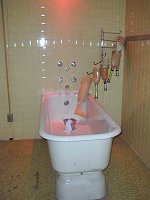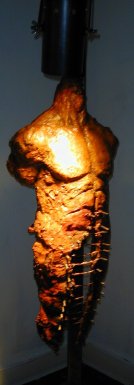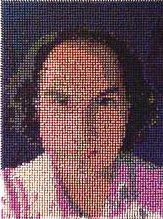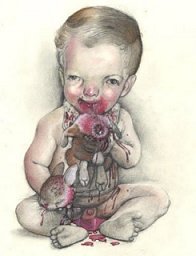This is a teaser of my review of Artomatic 2016, which is coming up after I make my third visit to the the show... can you pick how many blue chip artists have emerged from that AOM over a decade ago? Can you see why I like Artomatic?
Artomatic Energymatic Daggermatic
Art critics, like most writers, usually get paid by the word, sometimes by the article, and occasionally by an infinitesimal percentage of whatever profits their writing generates. And most art critics and writers visit a gallery show or museum exhibition, get a few handouts and spend about half an hour studying the works on the wall before heading home or to the office to pound the word processor’s keys and earn their buck-a-word for the review.
You can’t do that with Art-O-Matic, the huge, almost every two years, open visual arts extravaganza that this year hosted over 600 visual artists and another 400 performance artists at the laberynthic former convent building that last housed the Children’s Museum on 3rd and H Street, NE.
The idea behind Art-O-Matic is simple: find a large, empty building somewhere in the city; work with the building owners, and then allow any artist who wants to show their work help with staging the show and with some of the financial needs. This year, AOM artists paid a $60 entry fee plus worked a few hours assisting with the show.
And this year around 600 visual artists brought their art to the public.
In order to write a proper, ethical review of AOM, a writer must spend hours walking five floors of art, jam-packed into hundreds of rooms, bathrooms, closets and stairs. And I think that this is one of the main reasons that most art critics love to hate this show. It overwhelms them with visual offerings and forces them to develop a "glance and judge" attitude towards the artwork. It’s a lot easier to carpet bomb a huge show like this than to do a surgical strike.
Add on top of that an outdated, but "alive and kicking" elitist attitude towards an open show, where anyone and everyone who calls him or herself an artist can exhibit, sans the sanitizing and all-knowing eye of the latest trendy curator, and you have a perfect formula for dismissing a show, without really looking at it.
This quaint and elitist attitude towards art is not new or even modern. It was the same attitude that caused the emergence of the salons of the 19th century, where only artists that the academic intelligentsia deemed good enough were exhibited. As every art student who almost flunked art history knows, towards the latter half of that century, the artists who had been rejected from the salons (because they didn’t fit the formula of good art) organized their own Salon Des Refuses, sort of a 19th century Parisian Art-O-Matic.
And a lot, in fact, most of the work in the Salon Des Refuses was quite bad, but amongst the dreck were also pearls like Manet's Le Dejeuner sur 'Herbe (Luncheon in the Grass), Monet's Impression: Sunrise, (and we all know what art "ism" that title gave birth to) and an odd and memorable looking portrait of a young lady in white (The White Girl, Symphony in White, No. 1) by an American upstart by the name of James McNeill Whistler.
Everyone who was anyone in the art world hated and dismissed this anti-salon exhibition; except for the only "anyone" who actually counted: art history.
But then somewhere in the next century, the salons and their formulas returned. Only their name and their display styles had changed. They were now called Biennials, Biennales, Bienales, Documentas and their settings were in museums, entire cities or pristine white cubes around the world.
Only their reasoning and misguided logic remained constant: "Only we know what is good art."
And that is why these modern salonists and their acolytes will never respect, like, or understand Art-O-Matic: they recall that the Salons des Refuses almost broke their control over art; it won’t happen again.
And like the poet Marti wrote: "I know the monster well, for I have lived in its entrails." You see, over the last two decades I have been the juror, curator, decision-maker for hundreds of shows. And as a freelance art critic I have written and evaluated hundreds of artists and shows. I have been a minute gear in the world-wide machinations to keep control of what is art and never let a new Salons des Refuses wrest control again.
OK, OK, I know that am going overboard here; but... do you get the point?
But I am also an artist, and I like the concept of Art-O-Matic.
And not just because of the miles of artwork on display, much of which is mind numbing bad art; in fact, so bad that it is sometimes almost good in its exorbitant mediocrity. The main reason that I like Art-O-Matic is the palpable amount of artistic energy that it delivers to Washington, DC every couple of years. It is as if some invisible visual art battery in this ignored art scene comes to the forefront and gets recharged with brilliant white light (made as we all know, of all colors in the spectrum), and 50,000 people who generally would not set foot in a gallery or museum come and see art and artists and absorb the positive energy that only creative minds can generously give away.
So I enter my fourth Art-O-Matic with several preconceived ideas in my very subjective agenda:
(a) It’s going to take several visits and many hours to write my fourth review of Art-O-Matic in as many shows.
(b) There’s going to be a lot of dreck in the show. But art is in the eyes of the beholder; my dreck could be your pearl.
(c) I’m going to find several pearls in the show
(d) I’m going to re-charge my visual arts battery
(e) Our gallery will pick up some new artists from this show
On visit one, during the press preview, glass sculptor Tim Tate (Disclaimer: whom we represent and whom we "discovered" at a past Art-O-Matic) whizzes a group of us through the five floors of the show. It still takes three hours or so, but I have taken notes. Five visits and more than twenty hours later, I feel comfortable to start writing about the show.
A lot of the artists in the show are well known to me, and so I begin to discover "new" ones – at least new to me. Judy Jashinsky, who is one of the firebrand organizers who keeps this (and past) Art-O-Matics running, grabs me and asks me if I’ve seen Mark Jenkins’s pubic hair tapestries.
And Jenkins is one of the first memorable discoveries in this show. Tucked away in a corner space, Jenkins has created two noteworthy entries into the show. First in everyone’s lips are his photographic explorations of close-ups of pubic hair (loupe included in the installation) that through the magic of digital manipulation become interesting designs of elegant abstracted qualities. A second Jenkins emerges from his crowded little room: the tape sculptures.
Jenkins uses common transparent packing tape (yards and yards of it) to create superbly crafted and visually attractive figurative sculptures, as well as the odd, unusual organic shaped one. Through documentary photography, we see what happens when Jenkins places these plastic figures in a public venue. A passing man stares incredulously at a plastic man inside a dumpster; or a beach jogger is surprised by an alien looking tape creature that the sea has washed ashore.
Iver Olson is another talented discovery for me. He gets the award for the best porn in the show, although his display is also peppered with some otherwise just plain sensual photo-collages. It is almost as if there were two Olsons in the show: a really torrid, sensual photographer, and a brilliantly inventive pornographer.
In one of his photos, Olson has a woman with her hand buried inside the vagina of a second woman, who is sitting on a couch, seemingly bored, while her friend is searching inside her vagina, with (as an artist friend of mine put it) a "did a leave my keys in there?" sort of look. Somehow Olson has transformed the hardcore act of lesbian fisting into an almost funny scene of lustless abandon. Other good porn in the show is offered by Eduardo Rodriguez, Alexis Bine and Rudy K.
Another discovery is Ira Tattelman’s installation titled "They taught me to wash away my desires." I don’t know if it is because the building was once a convent, but there is certainly a strange, palpable energy in some parts of the building; people like Stephen King feed on this sort of energy and produce brilliant books; it is clear that Ira Tattelman also absorbed and channeled this energy into his installation.
"They taught me to wash away my desires" is inside a smallish bathroom furnished with a shower, a tub and some archaic 19th-century type bathroom stations (such as an enema station). Tattelman has installed a small pump in one of the stations that keeps re-circulating brownish, brackish water and add a watery sound to the room. To the right, inside and around the dirty tub is what at first sight appears to be a dismembered human body (they're actually some sort of artificial legs).
Put together the Stephen Kingesque feel of the room, the moist sound effects, the outdated chrome and dirty tile bath stations, and the human parts, and you have an installation that would give Hannibal Lechter a nightmare. It’s brilliant and somebody better put police ankle trackers on Tattelman now.
A couple more artists who deserve to be mentioned in the Hannibal Lechter art list are the very good and macabre sculptures by Stephon Senegal: this is a young artist to keep an eye on; in my opinion possibly the best sculpture in the entire show. Some other pieces by very good artists in this new trend of Lechterism are "Joroko" and also the installation "Sun Ray" by retro-recycling master Ray Jacobs.
M. Rion Hoffman really impressed me with her photography negative boxes installed along one of the main hallways. Hoffman’s boxes are delicate and have that ability to bring the viewer in for an intimate, close-up exploration of whatever story this talented artist wants to deliver. However, her large photo-collages, displayed next to her boxes, appear brutish and heavy handed by comparison, although part of me kept being re-directed from them to her brilliant boxes.
Matt Dunn is a mother load of photographic talent with a built-in magnet to attract, discover, capture on silver gelatin film, and then show us, the really interesting, throat-clearing substrata of human society that makes Diane Arbus’ photographs look like Sears portraits. This is a master portraitist in his element.
In the glass room, Washington Glass School directors Tim Tate and Erwin Timmers have created the most professional looking set of rooms in the entire building and provided the means to discover a couple of new talents in that beautiful genre. Another fact that surfaces very quickly is that the Washington Glass School is certainly stamping its own imprimatur, its own "school brand" in a sense, upon many of our area’s young glass artists. I particularly liked the figurative "man" vessels of Michael Janis, where Janis takes Tate’s seminal idea of narrative biographical wall panels and marries it with Tate’s apothecaries (nine of which were acquired by the Renwick Alliance) to deliver a fresh, new set of ideas in glass.
In these rooms I also liked Syl Mathis, who reminds us that the true beauty of glass lies mainly in its simplicity. Mathis delivers a series of pieces exploring the "boat" theme in glass. I preferred the simpler, more elegant forms by Mathis over some of the more elaborate pieces, perhaps made a bit distracting by their complex support stands and crafty materials.
Allison B. Miner is a very talented painter, and at the last Art-O-Matic, where I first discovered her small, in-your-face paintings, I singled her out as one of the best painters in that show. Miner is still one of the best painters in this show, and her talent with the brush and composition is clearly evident to the most casual observer. I do however, think that it is time for Miner to move on and push her enviable painting skills beyond the tight, close-up routine that she has come dangerously close to boxing herself in. This is a very good painter at the beginning of her career and I am sure that we are but seeing but a tiny bit of what Miner can and will deliver.
Joseph Barbaccia is another artist whom I have been observing for the last few years and this year his crayon self-portrait – literally made out of hundreds and hundreds of crayons in a postmodern pointillist style – easily qualifies as one of the best pieces of art in the whole AOM.
Barbaccia is hard to pin down as a painter, sculptor, uh... crayonist? He explores and pushes art in all dimensions.
Staying within two dimensions, and doing a magnificent job of it are three enviably talented painters: Margaret Dowell, Michal Hunter and Jeffry Cudlin. All of these artists have that spectacular technical mastery of the brush that it is so easily dismissed by people who have never tried to mix cerulean blue with Payne’s gray and ended up with mud. Dowell’s paintings show not only extraordinary technical skills, but also a hungry sense of desire and intelligent understanding of her subjects – who are often transgender and cross dressing personages around our area.
Michal Hunter is also a technical virtuoso of the brush, with only one painting in the entire show; tucked away so far and so difficult to find, that had I not run into Hunter while she was on hallway monitor duty, I would have missed it completely. I am glad that I didn’t, as it is a very powerful work by a woman who is slowly re-affirming her once solid place in the Washington, DC art scene.
Jeffry Cudlin surprised me by delivering some very strong compositional works that are really excuses for Cudlin to use a representational subject to offer works such as "Author, Author," that are really more about the intelligent employment of color and shapes and composition. I write that he surprised me because I am not usually a big fan of these sorts of "interior" works. However, because the paintings are all about shape, color and composition, I found myself admiring them for those points, rather than for their subject matter.
Creating a new place for himself is an illustrator named Scott Brooks, who in this new Art-O-Matic incarnation is like a strange, macabre John Currin, but can paint and draw a lot better than Currin ever learned to. A lot of people were talking about Brooks' disturbing images; this is usually a sign of success for any visual artist. Both the police and art collectors need to keep an eye on this talented artist.
But quite possibly the most talked about (well, at least the most listened to) pieces in the show are the two robotic installations by Thomas Edwards.
Located on the main hallway of the fourth floor, Edwards first greets the passerby with an installation of several of those mechanical talking fish that move their heads and sing songs. He has changed the original recordings and instead of a Christmas carol, the fish now beg you to stop eating their eggs or complain that they’re dying, etc. It is funny and inventive. Edwards’ second piece is a motion sensing robotic head that follows you along a wall track and peppers you with irritating questions like "where did you get your hair done?"
Edwards’ installations are intelligent creative and they fit well right into the Hollywoodism tradition of past Art-O-Matics.
There is a lot of channeling of well-known artists in this AOM. Two artists stand out: Mark Stark channels Dan Flavin and Erin Hunter continues to somewhat channel Erik Sandberg.
I also enjoyed Bridget Vath’s very inventive use of Kevlar to design and construct dresses and other clothing apparel; I suspect that Vath could start a very successful line of Kevlar clothing with good markets in Baghdad, Beirut, Bogotá, Atlanta and most of the Balkans.
The funniest piece in the show, other than Thomas Edwards’ annoying talking fish is also one of the most famous paintings in the world.
I am referring to Kayti Didriksen’s now infamous portrait of Bush and Chaney titled "Man of Leisure: King George," where Didriksen has regurgitated Manet’s famous painting Olympia and has Vice President Chaney serving an oil well to a nude Dubya.
This image, a few weeks ago, at the height of the Funky Furniture controversy with the City Museum, was the most downloaded Internet image in the world.
It is a terribly funny, badly painted and highly successful work. Didriksen not only captures Bush’s likeness perfectly but also delivers an interesting expression (that’s perfect for the subject) in the much abused President (abused by a lot of AOM artists that is) and also offers a hilarious VP Chaney with a neck that seems inflamed by gout.
As with past AOM’s, a lot of artists explore the nude human figure in both paintings and photographs. This is a subject not usually seen in Washington area galleries, and I can't recall the last time that I saw an exhibition of nudes in any of our area’s museums. I noted Peggy McNutt, Shannon Chester (especially well done is "No. 10, Chair 2"), Adrienne Mills, Chris Keely, Dana Ellyn Kaufman and Candace Keegan.
Of these, Kaufman and Keegan both use their own bodies to deliver interesting ideas and suggestions. In Kaufman’s case, extremely acidic, caustic and pointed commentaries with provocative titles married to insane figurative paintings. In Keegan’s case, she pushes a lot of moist buttons in our psyche by playing with stereotypical Hustlerian depictions of women: See Keegan suggestively sucking on her necklace; see Keegan in pigtails offer her breasts to the viewer. However, in the end what we do see are two strong women who use their art intelligently and use the taboo nude to converse elegantly with the viewer.
There is a lot of forgettable abstraction at AOM. Two artists who stand out from the masses (and happen to be sisters) are Andrea Cybik and Jan Sherfy. Their work explores colors and action and also stands out by their very professional presentation.
In summary, I’ve been to every single Art-O-Matic ever staged, and I am in the minority opinion that they’ve improved each time, and each time they give us a most precious gift: the energy that only several hundred creative minds working together can deliver. I hope Art-O-Matic grows to become a national level open show and then grow some more and become a worldwide showcase for the world’s largest open international art exhibition and a new dagger to the heart of the 21st century salons.
